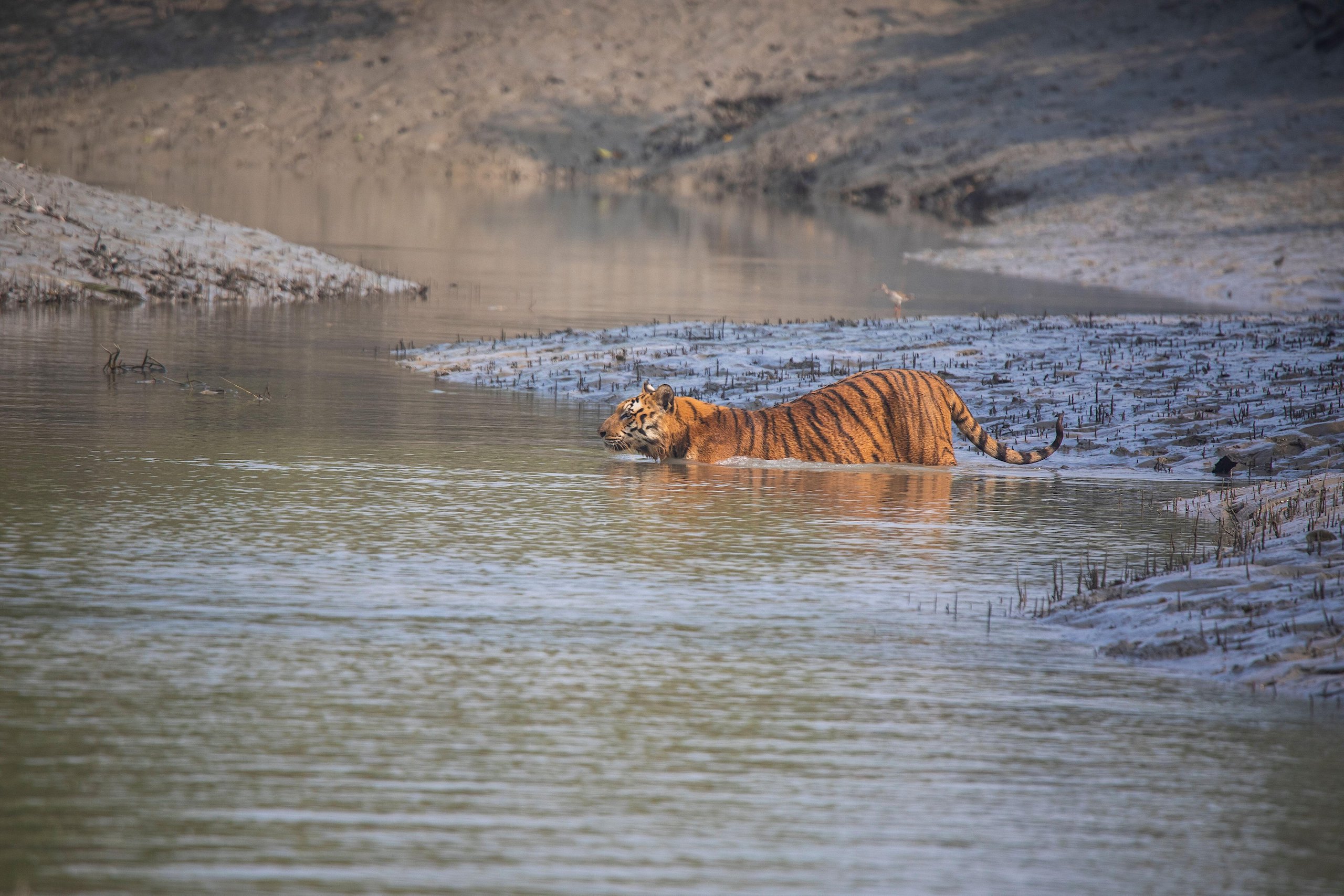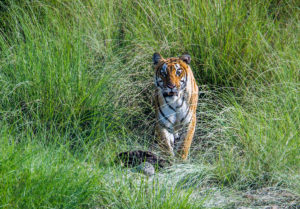As Bangladesh seeks to increase the number of endangered tigers in the country, officials are rethinking a reintroduction plan that would involve bringing the big cat back to the Chittagong Hill Tracts (CHT), The Third Pole has learned.
The plan, which made headlines in 2020, would have entailed releasing tigers in the remote area of south-east Bangladesh, which borders India and Myanmar.
However, a feasibility study has found that conditions are not currently suitable for a successful reintroduction. While there has been no official announcement to this effect, The Third Pole’s conversations with key officials have revealed that the Bangladesh Forest Department appears to have stepped back from the plan for the time being.
“Two things – habitat and prey – need to be considered before releasing tigers in the CHT,” said Md Amir Hosain Chowdhury, the chief conservator of forests at Bangladesh’s Ministry of Environment, Forests and Climate Change. “We have found that the habitat is not suitable right now and there is not enough prey for tigers in the hill tracts. Human settlements are a big problem there, too. So, we have retreated from our plan.”
Tigers were once widespread in Bangladesh. As recently as the 1930s, they were reportedly present in 11 out of 17 districts in the country. “However, widespread hunting and forest depletion have reduced the tiger’s range and numbers,” says Bangladesh’s Tiger Action Plan for 2018-2027, prepared by the country’s forest department as a blueprint for tiger recovery.
The only resident tiger population in Bangladesh is found in the Sundarbans, the world’s largest mangrove ecosystem formed by the confluence of the Ganga, Brahmaputra and Meghna rivers in the Bay of Bengal.
In 2020, when Chowdhury revealed the government’s intentions to reintroduce tigers to the Chittagong hills, he said that the area “was the host of a huge number of tiger populations” in the past. The announcement was consistent with the government’s Tiger Action Plan for 2018-2027, which listed ensuring a “viable tiger population in the Chittagong Hill Tracts” as a low-priority goal, and indicated required resources of 100 million Bangladeshi taka (around USD 914,000) over a 10-year period. But the plan has evidently been put on hold.
In some parts of the world, threatened predator species have made a promising comeback thanks to a combination of efforts to reduce hunting, restore habitats and reintroduce the animals in areas where they had been extirpated. But the success of reintroduction efforts depends on multiple complex factors being in place, including limiting threats to the reintroduced animals, adequate prey and the consent and cooperation of nearby communities.
Chowdhury told The Third Pole that the Forest Department is now working to regenerate forests in the Chittagong Hill Tracts, and that it will consider releasing tigers there once the restoration is complete.
First launched in 2009, the Bangladesh Tiger Action Plan is a government-led strategy for the long‐term conservation of tigers in Bangladesh. So far, two editions have been released, covering 2009-2017 and 2018-2027. In these documents, the Bangladesh Forest Department outlines goals and objectives to guide tiger conservation programmes in the country.
The stated aims of the 2018-2027 Tiger Action Plan are to increase tiger density in the Sundarbans; maintain a sufficient prey base to support the Sundarbans’ tiger population; maintain habitat and habitat diversity to support tiger and prey populations in the Sundarbans; and to ensure a viable tiger population in the Chittagong Hill Tracts.
The feasibility study
Imran Ahmed, conservator of forests at the Bangladesh Forest Department, explained that a feasibility study was conducted in 2021 with a view to gather “evidence of tigers [and their] habitat suitability which includes the availability of prey species in the remote forest patches of the CHT”. The government-funded feasibility study project was conducted by the Forest Department with technical assistance from IUCN Bangladesh.
The resulting report – which has not been made public – maintains that there is no solid evidence of tigers being present in the Chittagong Hill Tracts. This is despite reports of tigers being seen crossing the Kasalong River, a major waterway that runs through the region, in 2021.
According to a government official who shared the key findings of the report with The Third Pole, but who requested anonymity, factors that were considered in the study included the availability of prey species; maintenance of genetic diversity; and the local population’s response to the idea of reintroducing tigers.
Unless these circumstances change, the report says, it is unlikely that any reintroduced tiger would survive. In conclusion, Ahmed says, the study findings were not positive, and do not support attempts to reintroduce tigers in the Chittagong Hill Tracts for the time being.
Ambiguity over tigers in the Chittagong hills
The 1,645 square-kilometre Kasalong Reserve Forest in the CHT is still relatively undisturbed, its dense, evergreen forests being mostly untouched by human settlements and cultivation. The forest is home to many mammals including Asian elephants, two species of bear, three species of deer, leopards and wild boar.
Debate over whether some tigers, too, have survived has been ongoing for years. Pugmarks (paw prints) seen in the area in 2016 were believed by some experts to be from tigers.
M Monirul H Khan, a tiger expert who was involved in the CHT feasibility study, told The Third Pole there was some evidence of tiger presence in the region. “During our expedition to Kasalong Reserve Forest, we found remains and a [tiger] skull at a hunter’s house,” he said.
Ishtiaq Uddin Ahmed, a former chief conservator of forests at the Bangladesh Forest Department, said that more scientific studies are needed to establish whether pugmarks reported in the Chittagong Hill Tracts are from resident tigers, or from tigers coming over the border from India and Myanmar.
“We will not be able to say [what] the actual status is of tigers in the hill tracts without a proper survey,” he added.
Md Shabab Uddin, Bangladesh’s minister for environment, forest and climate change, told The Third Pole: “Considering all the threats, we are not taking a decision right now to reintroduce tigers in the CHT but we have a plan to do so in the future.”
Uddin said that before making plans to relocate tigers from the Sundarbans to the Kasalong Forest Reserve in the CHT, the Bangladesh government has first to achieve another goal in its Tiger Action Plan, to “minimise poaching of tigers and prey, minimise habitat destruction, initiate habitat restoration and establish connectivity between the fragmented habitats”.
“The reintroduction of tigers in the Kasalong Reserve Forest will depend on the results of the strategic action [plan] as well as the full support of the local tribal community,” the minister told The Third Pole.











